This post may contain affiliate links. Please read our disclosure policy.
This versatile recipe for gluten free biscuits makes tender and light pastries that are the perfect side to any meal. Make them as drop biscuits or rolled out and cut into rounds!

“My oh my. Those biscuits were so satisfying.
All y'all need to try this! And I forgot the Star Rating on the comment I just left. Disappointed there are only 5 – should have been 6!”
I don't know about you, but I don't want to spend forever making dinner each night. They're just going to eat it and forget it, no matter how good it is. And I don't want to prepare the same meal every night any more than they want to eat the same meal every night.
When I'm making rice or gluten free pasta night after night, even if the rest of the meal wasn't a repeat, I found it inexplicably sad. This easy gluten free biscuit recipe makes a buttery, satisfying side dish that's quick enough for a weeknight dinner—especially if you make them as drop biscuits.
Table of contents
Why you'll love these biscuits
- Quick & easy: If you're making drop biscuits, all you have to do is combine the dry ingredients, add cold butter, add buttermilk, scoop and bake. They can be ready in 20 minutes flat!
- No waiting: Since biscuits are pastry, all of your ingredients should be cold. That means no waiting for butter to soften or eggs to come to room temperature.
- Freeze beautifully: You can freeze shaped, raw biscuits and bake them right from frozen any time. Or you can freeze them baked, sprinkle with water and defrost and refresh like new!
- Ideal side dish: The perfect alternative to pasta, rice, or potatoes with your gluten free fried chicken!
How to choose between drop or rolled biscuits
This recipe has the same ingredients whether you make them as scoop-and-drop biscuits or cutout biscuits. Cutout biscuits do have a little less moisture, and they're rolled and folded, then cut out, a bit like laminated gluten free puff pastry.
Here are the questions to consider when deciding how to shape your biscuits:
- How much time do you have? Drop biscuits can be in and out of the oven in less than 30 minutes. Layered biscuits call for more shaping and a bit of chilling.
- What texture do you prefer? Drop biscuits are more dense and crusty with craggy buttery edges that get crispy in the oven. Rolled biscuits are layered and flaky, have a softer crumb, and are lighter and fluffier.
- Are you comfortable rolling dough? Some people don't like to break out the rolling pin. If that's you, make the drop biscuits and just mix, scoop, and bake.
- Do you want them to be like Pillsbury grands? If you miss the flaky layers of Pillsbury and you want them to be like gluten free biscuits in a can, make the layered biscuits! It's worth the extra step.
This gluten free biscuits recipe is special no matter which way you make it, though. You probably have all of its ingredients right there in your gluten free pantry.

Ingredient notes
- Gluten free flour – Choosing an all purpose gluten free flour blend carefully is important in all good recipes, but it's even more important in a pastry recipe with only a handful of basic ingredients like this one. Be sure you add 1 heaping teaspoon of xanthan gum if you're using Nicole's Best multipurpose gluten free flour, since it doesn't already contain xanthan gum. King Arthur Flour blends just won't work here.
- Cornstarch – Adding a bit of cornstarch helps to soften the blend and create a lighter crumb. If you're using Cup4Cup, though, that already has too much cornstarch so replace the 14/ cup (36 grams) cornstarch with an equal amount, by weight, of Cup4Cup.
- Baking powder – serves as a leavening agent, an ingredient that help baked goods rise and get fluffy
- Baking soda – this is also a leavener, but it is here mostly because it helps the biscuits to brown in the oven
- Salt – salt plays a big role in bringing out the flavor of these buttery biscuits
- Sugar – there's only two teaspoons of sugar in this recipe, and while it does add a tiny bit of sweetness, it helps keep the biscuits tender and adds some complexity to the flavor
- Butter – as the moisture in butter burns off, it creates tiny steam pockets that give the biscuits such a light, airy texture; keep it cold so your butter doesn't melt into the batter, but instead puffs it out
- Buttermilk – it adds a lovely flavor and helps make the biscuits fluffy and tender
How to make this easy gluten free biscuit recipe
These step by step photos for how to make this recipe are designed to make it easy for you to imagine exactly what this recipe calls for. For full instructions including exact quantities and a full printable recipe, be sure to scroll down to the recipe card.
Whisk dry ingredients & add butter
Whether you're making drop gluten free biscuits or rolled and cutout biscuits, begin by whisking together the dry ingredients and tossing the butter in them. For drop biscuits, add in grated or finely chopped butter. For rolled biscuits, add coarsely chopped butter and flatten it in the flour.


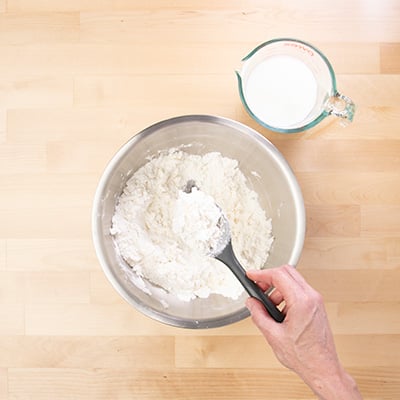
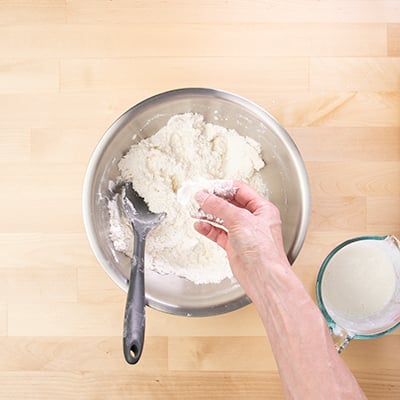
Add buttermilk & shape drop gluten free biscuits
For both shapes, mix in buttermilk to create a relatively wet dough. For drop biscuits, mix, scoop with dough with an ice cream scoop, then brush with melted butter. For layered biscuits, you'll add a little less buttermilk. We'll shape those below.
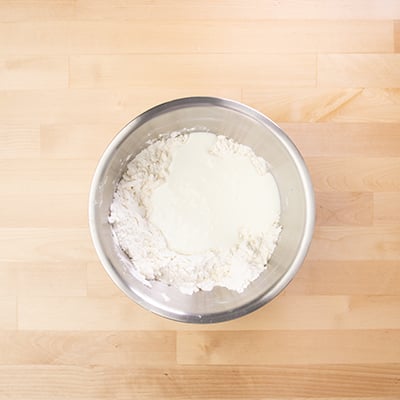
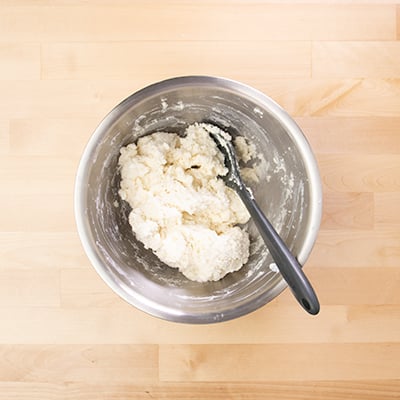
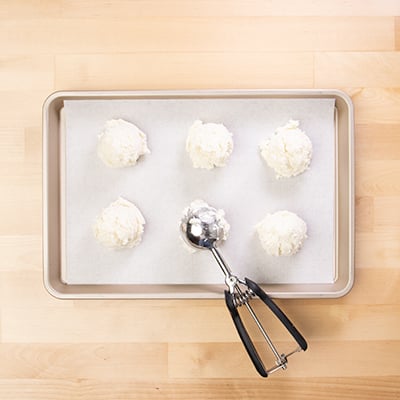
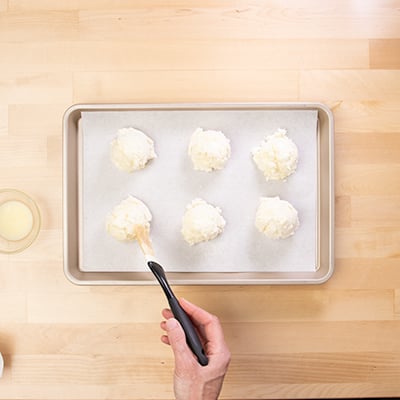
Roll out layered biscuit dough
For the cutout dough, add all but about 2 tablespoons of the buttermilk, & only add more to any very crumbly bits of dry ingredients. Roll the dough into a rectangle, fold it like a business letter, and roll it again. Repeat at least 3 times, sprinkling with flour as you go.

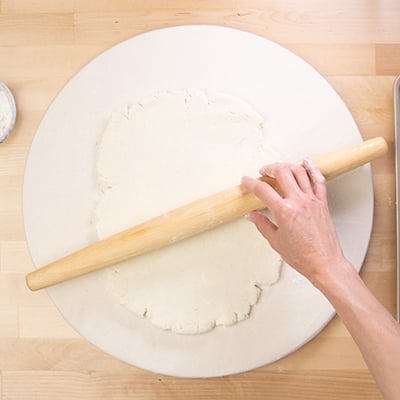
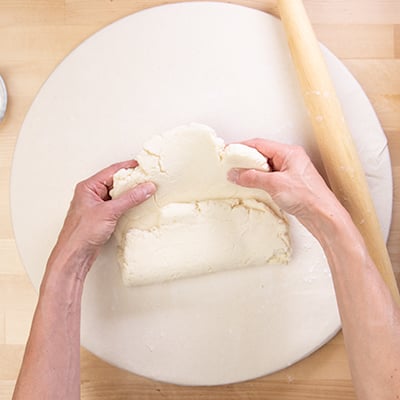
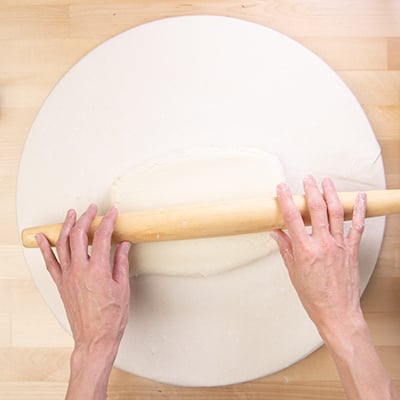
Cut layered dough and prepare to bake
Cut out shapes of the rolled dough using a cookie cutter or biscuit cutter, and place them on a baking sheet. Chill the cutouts, since we've handled the dough quite a bit and we need it cold in the oven.


Bake at 425°F
Whether you've made drop biscuits or rolled cutout biscuits, bake them in a 425°F oven for 15 to 18 minutes. The drop biscuits tend to take a few minutes longer to bake than the layered biscuits, so those take closer to 18 minutes to bake. Let the biscuits set on the baking sheet for just a couple minutes, and enjoy!
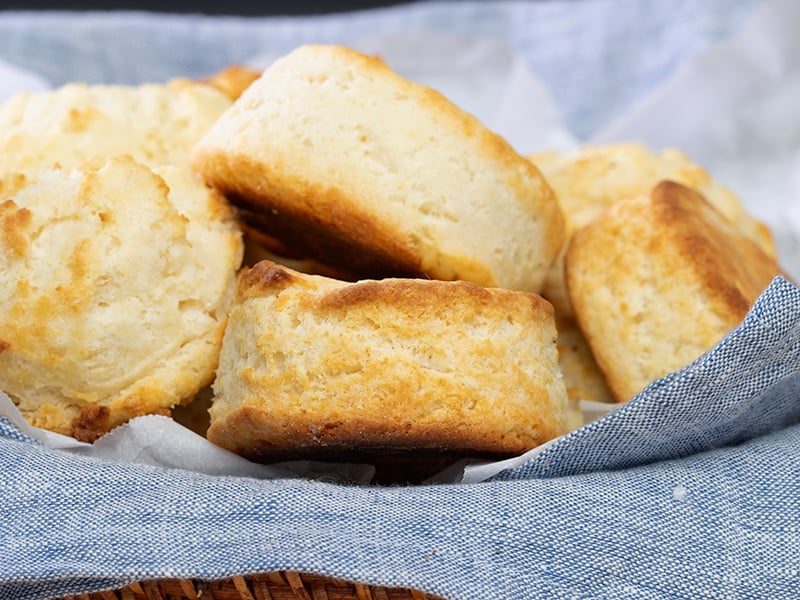
How to make drop biscuits that are still light
If you're making rolled and cutout biscuits, lightness will come from layers of flour alternating with layers of cold butter that puff and expand in the heat of the oven.
With drop biscuits, we use smaller pieces of butter, just the right ingredients (of course!), a slightly wetter dough, and a light, light touch. Drop biscuit dough is handled very little, so it's easy to keep those ingredients cold!
More recipe tips & tricks
Keep your ingredients cold
The secret to making pastry is to keep the cold ingredients that way. If your butter liquefies before the biscuits start baking, your biscuits are going to be dense and hard.
To help keep the butter cold, be sure to turn on your oven before you start preparing the biscuit dough, and keep the butter and buttermilk in the refrigerator until you're ready to add each of them to the mixture. If you find that the butter is melting at all as you're working, return it to the refrigerator again until it's firm.
Measure your gluten free flour blend by weight
Because this gluten free drop biscuit recipe doesn't have a lot of ingredients and relies on precise measurements to ensure the lightest, fluffiest texture, it's essential that you measure your gf flour by weight rather than volume.
Measuring by weight really is the only way to ensure that you've got just the right amount of flour, so pull out that kitchen scale (or pick one up if you don't have one — I really like this kitchen scale on Amazon (affiliate link; feel free to shop around!)).
Don't handle the drop biscuit dough
Once you've mixed the drop biscuit dough, it's best to avoid handling it as much as possible. Instead, use an ice cream scoop, two spoons, or a spoon and spatula to scoop the dough and drop it onto your baking pan.
In addition to keeping your hands clean, this will help prevent your butter from melting since it won't come into contact with the warmth of your skin. If you're having any trouble getting your biscuit dough to release from the ice cream scoop, try dipping the scoop in ice water before each portion.
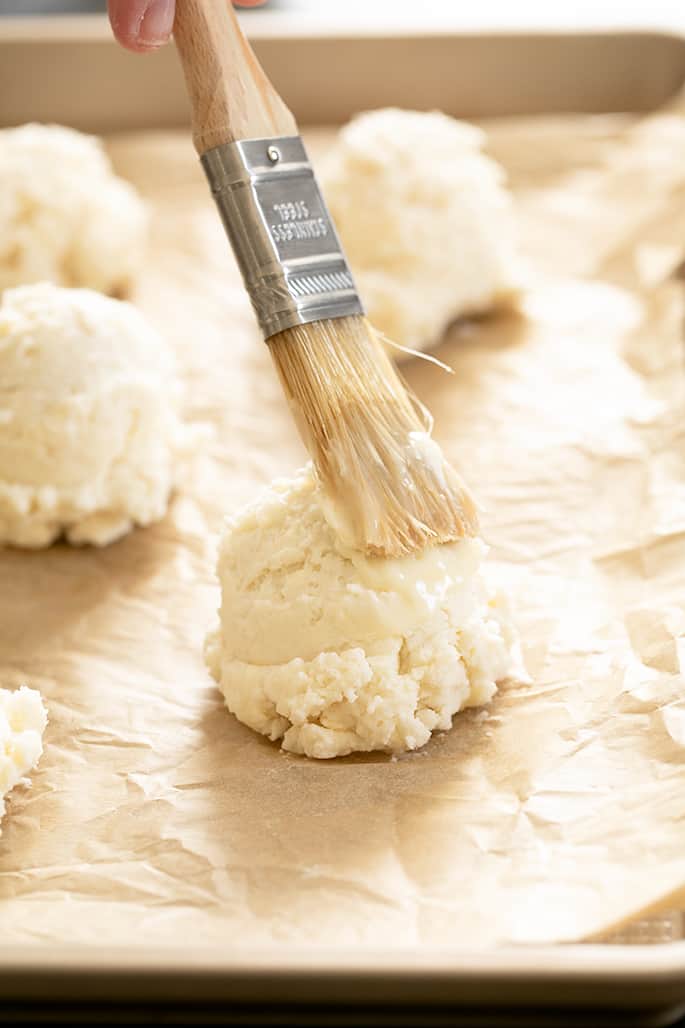
How to store leftover biscuits
If you have leftover biscuits of either shape and think you might eat them within the next 12 hours, place them in a sealed glass container and store them at room temperature.
For longer storage, let them cool completely, then freeze them in a single layer on a baking sheet. Once they're frozen, pile them into a freezer-safe bag for up to a month.
How to refresh biscuits
Defrost frozen biscuits at room temperature first. Once they're defrosted, or if you've stored them at room temperature, you can refresh them by sprinkling them with lukewarm water and placing them in a 300°F oven or toaster oven until warmed through. The water keeps them from drying out during reheating.
Making biscuits in advance
All you have to do is prepare the easy gluten free biscuit dough, drop the biscuits onto a parchment lined baking sheet, and then put the whole thing in the freezer rather than the oven.
Once they're frozen, remove them from the freezer and pile them into a freezer-safe zip-top bag. Bake them right from frozen, but begin with the oven at 400°F and increase it to 425°F after 5 minutes. You will probably need to add a few minutes to the baking time.
Recipe ingredient substitution suggestions
Dairy free biscuits
The dairy in these biscuits is in two forms: buttermilk and butter. The buttermilk can easily be replaced with 1/2 cup (129 g) plain dairy-free yogurt + 1/2 cup (4 fluid ounces) unsweetened nondairy milk. Adding some lemon juice or vinegar to milk won't create a true buttermilk substitute, since real buttermilk
For butter, the best replacement is 4 tablespoons (56 g) Spectrum brand nonhydrogenated vegetable shortening + 4 tablespoons (56 g) Melt brand or Miyoko's Creamery brand vegan butter. You can use all vegan butter, but the biscuits are more likely to spread. Whatever vegan butter you use must be solid at room temperature.
Corn free biscuits
Cup4Cup and Nicole's Best gluten free flour both contain cornstarch, so if you can't have corn, you'll need to use Better Batter. If you're using Better Batter, try replacing the cornstarch in the recipe with arrowroot or potato starch.
Do you need xanthan gum to make these gluten free biscuits?
To make this recipe for gluten free biscuits, you need xanthan gum. But you can still make amazing gluten free drop biscuits without xanthan gum.
If you'd like to make easy drop biscuits but you're sensitive to xanthan gum and guar gum, try our gluten free biscuit recipe without xanthan gum. It has a different flour blend, and uses something called konjac powder instead of xanthan gum.
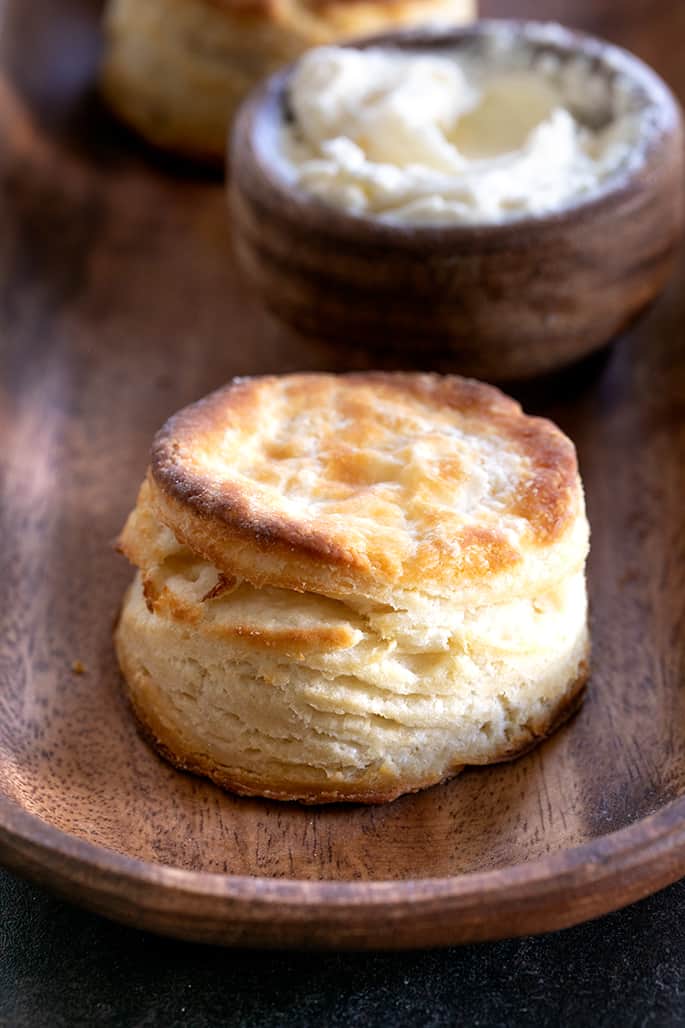
FAQs
Drop biscuits are easier to scoop and drop onto a baking pan. Drop biscuits also don't have the layers that come with rolled biscuits, but they're still buttery and delicious.
Your dough may be dry because you used a different gf flour than what I recommend. Some brands, like King Arthur Flour, are starchier than others, so they soak up liquid and get dry.
If you did use one of my recommended blends, you may have overmeasured your flour. If you made rolled biscuits, you may have incorporated too much flour into the biscuit dough during shaping, or the butter may have melted while you were handling it. Next time, make the butter chunks larger and chill the dough if the butter begins to melt.
Yes, you can bake these easy gluten free biscuits in a cast iron pan, but you'll need to watch them carefully as the heated pan will cause them to bake more quickly.
If your gluten free biscuits are flat, not puffy, there's a good chance that your butter melted before the biscuits got into the oven.
This generally happens when you use warm ingredients (butter that's been sitting out) or let your dough sit while the oven is preheating.
For your next batch, do everything you can to keep that butter and buttermilk as cold as possible.
Yes, you can make your dough in advance by keeping the prepared dough in the fridge until you need it. If you're making drop biscuits, make sure to keep the dough tightly covered to keep it from drying out, and try to use it within a few hours. If you're making rolled biscuits, shape the dough into rounds before refrigerating it.
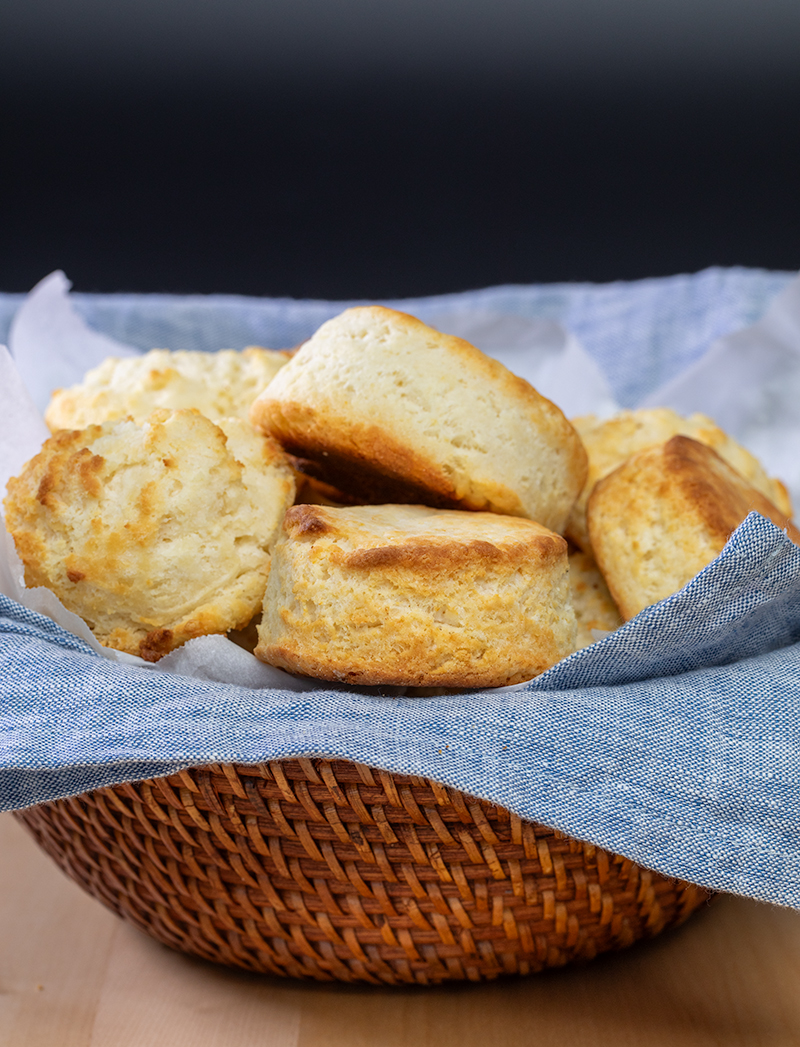
Gluten Free Biscuits Recipe
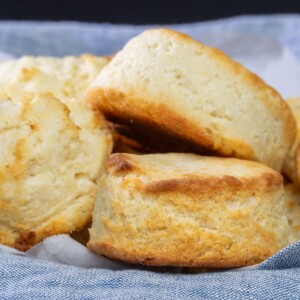
Ingredients
- 1 ¾ cups (245 g) all purpose gluten free flour blend, plus more for sprinkling (please click thru for full info on appropriate blends)
- 1 teaspoon xanthan gum, omit if your blend already contains it
- ¼ cup (36 g) cornstarch, (or try potato starch or arrowroot)
- 1 tablespoon baking powder
- ½ teaspoon baking soda
- ½ teaspoon kosher salt
- 1 tablespoon (12 g) granulated sugar
- 8 tablespoons (112 g) unsalted butter, chilled
- 1 cup (8 fluid ounces) buttermilk, chilled
- 1 tablespoon (14 g) unsalted butter, melted (optional; for drop biscuits)
Instructions
- If you're making drop biscuits preheat your oven to 425°F. If you're making rolled biscuits, preheat your oven while the shaped dough is chilling in the refrigerator.
- Line a large rimmed baking sheet with unbleached parchment paper and set it aside.
- In a large bowl, place the flour blend, xanthan gum, cornstarch, baking powder, baking soda, salt, and sugar, and whisk to combine well.
To make drop biscuits
- Using a standard box grater, grate the chilled butter. If it melts at all during preparation, place the grated butter in the refrigerator until firm.
- Add the grated and chilled butter to the bowl of dry ingredients, and toss to coat the butter in the flour mixture.
- Create a well in the center of the dry ingredients, add the buttermilk and mix until just combined.
- Working quickly, so the dough doesn’t get warm, drop the batter by the quarter cup using two large spoons or a 2-inch ice cream scoop about 1 1/2-inches apart on the prepared baking sheet. Do not pack the dough into the ice cream scoop.
- Brush the tops of the mounds of dough lightly with the melted butter. This step is optional but helps the biscuits brown in the oven.
- Place the baking sheet in the center of the preheated oven and bake until lightly golden brown all over (15 to 18 minutes). Remove from the oven and allow to set briefly before serving.
To make rolled biscuits
- Using a sharp knife, cut the butter into a large (3/4-inch) dice. If it melts at all during preparation, place the diced butter in the refrigerator until firm.
- Add the chopped butter to the flour mixture and toss to coat. Place each piece of butter between your floured thumb and forefinger to flatten, working quickly to ensure that you don’t melt any of the butter.
- Create a well in the center of the dry ingredients, and pour in all but about 2 tablespoons of the buttermilk.
- Mix with a large spoon or spatula until the dough comes together. The dough will be shaggy, with some irregular edges. Mix in more buttermilk by the drop if there are any dry bits.
- Press the dough into a disk. If it doesn't seem cold any longer, place it in the refrigerator to chill for about 5 minutes or until firm.
- Dust the dough with a bit more flour, and roll with a rolling pin into a rectangle about 3/4-inch thick.
- Fold the rectangle in thirds like you would a business letter and press it together lightly to help it adhere to itself.
- Sprinkle the outside of the dough lightly with more flour, and roll it out again into a thick rectangle, sprinkling it with more flour as necessary to prevent sticking.
- Repeat this process of rolling and folding 1 or 2 more times, dusting with flour as necessary and chilling the dough if the butter begins to melt at all. After the final folding, dust the dough again lightly with flour, and roll it into a disk about 1-inch thick.
- With a floured, round biscuit cutter or cookie cutter (about 2 inches in diameter), cut out rounds of dough by pressing firmly and cutting quickly.
- Place the raw biscuit cutouts about 2-inches apart from one another on the prepared baking sheet. Gather and reroll scraps, and cut out as many more rounds as possible, placing them on the prepared baking sheet.
- Place the baking sheet in the freezer for 5 minutes to chill the dough until firm (or in the refrigerator for 10 minutes or until firm).
- Preheat your oven to 425°F while the biscuits are chilling.
- Once the dough is firm and cold, and the oven is hot, place the baking sheet in the center of the preheated oven. Bake until the biscuits are puffed and pale golden, about 15 minutes.
- Remove the baking sheet from the oven and allow the biscuits to cool on the baking sheet until firm (about 5 minutes). Serve warm or at room temperature.
Video
Notes
Nutrition
Nutrition information is automatically calculated, so should only be used as an approximation.

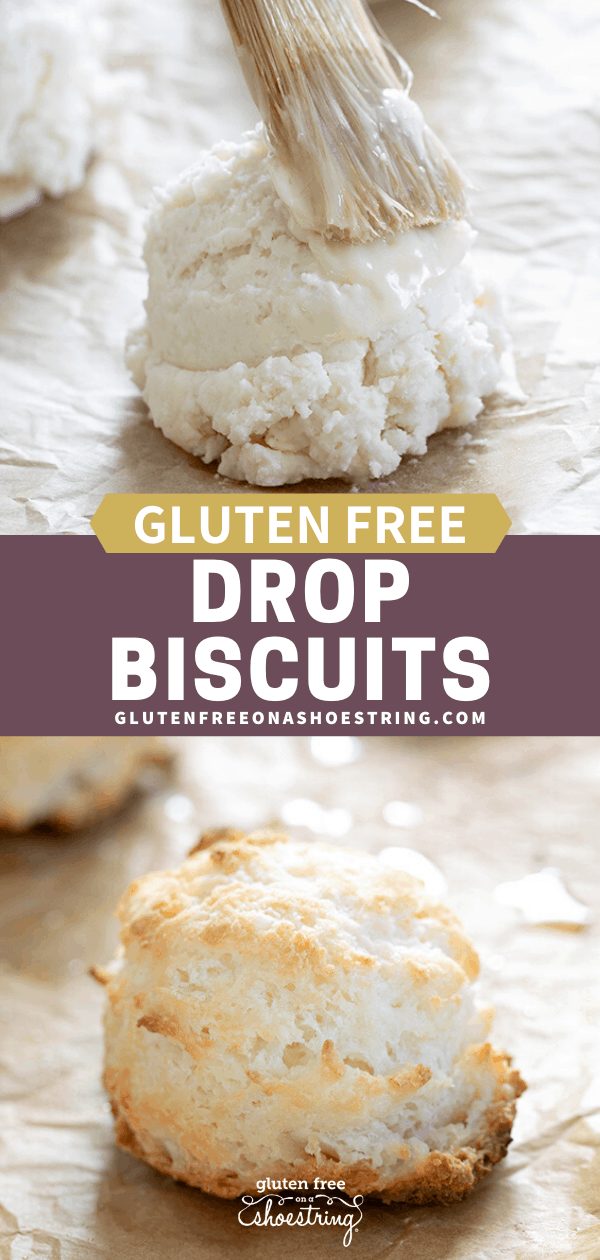
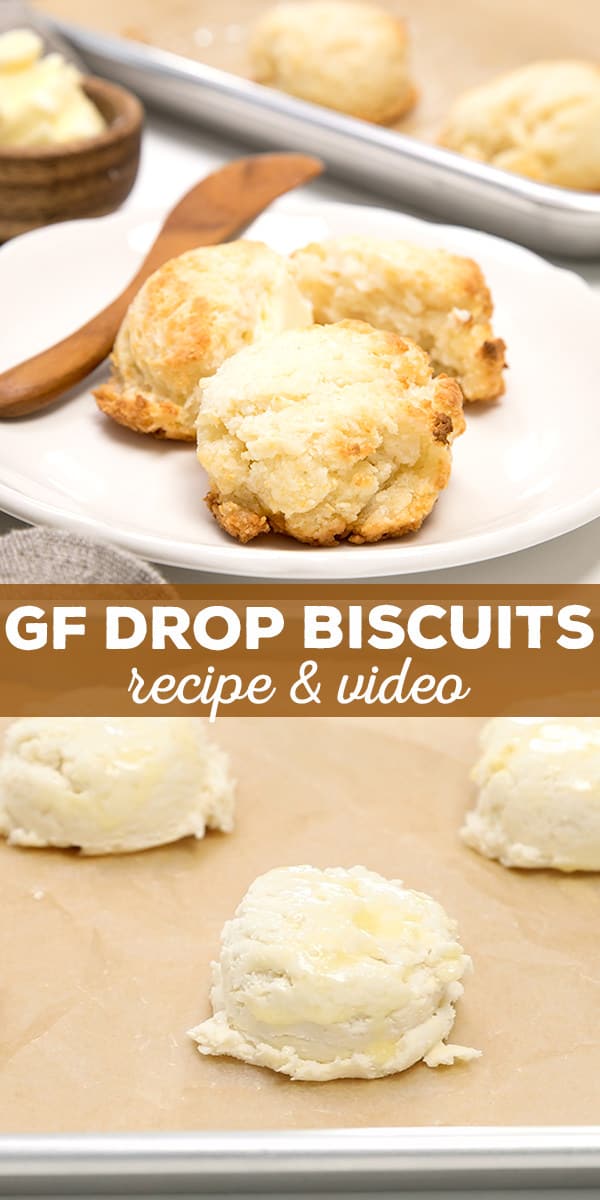
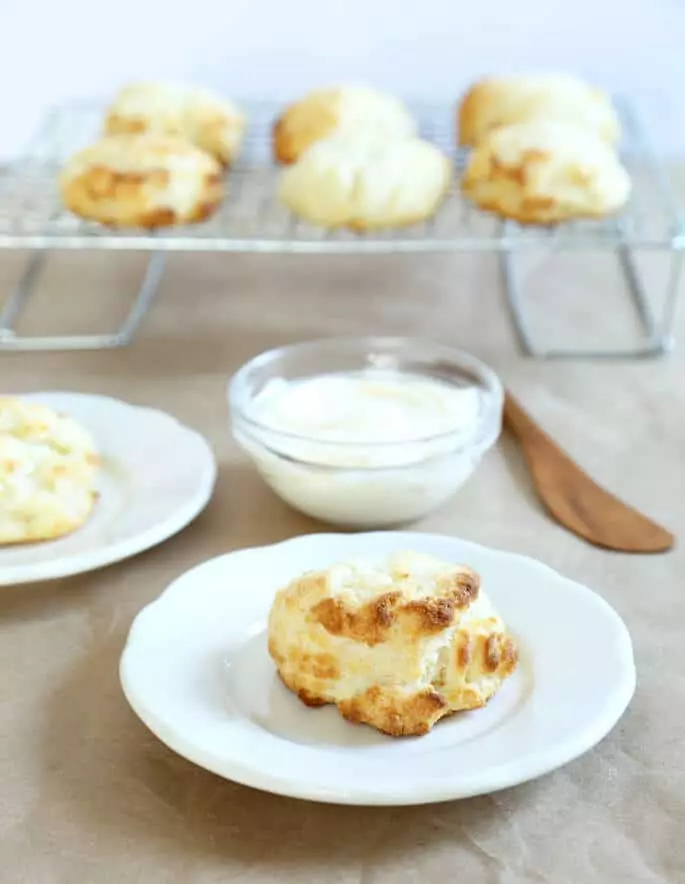

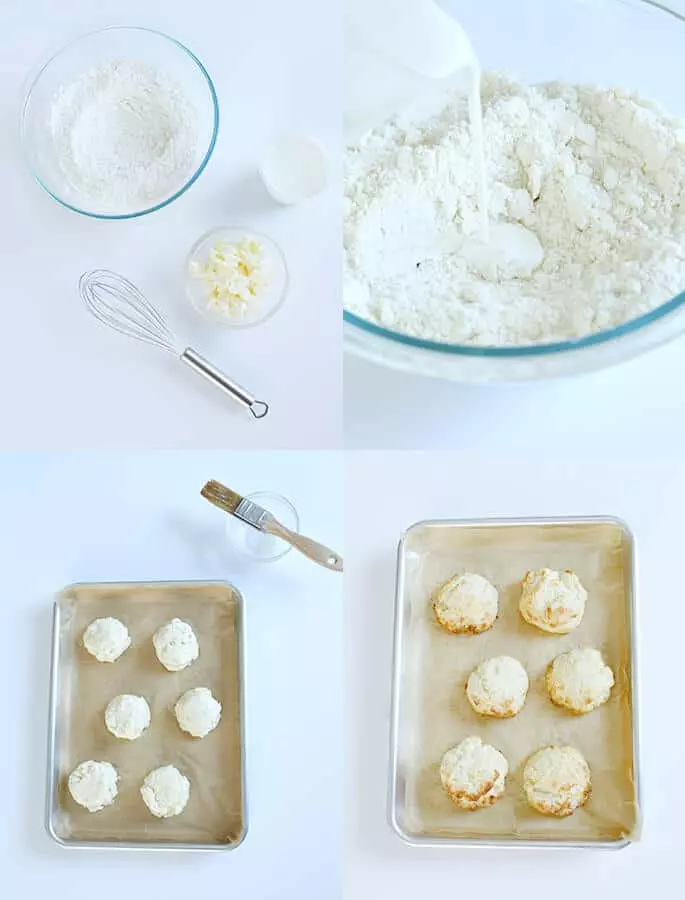


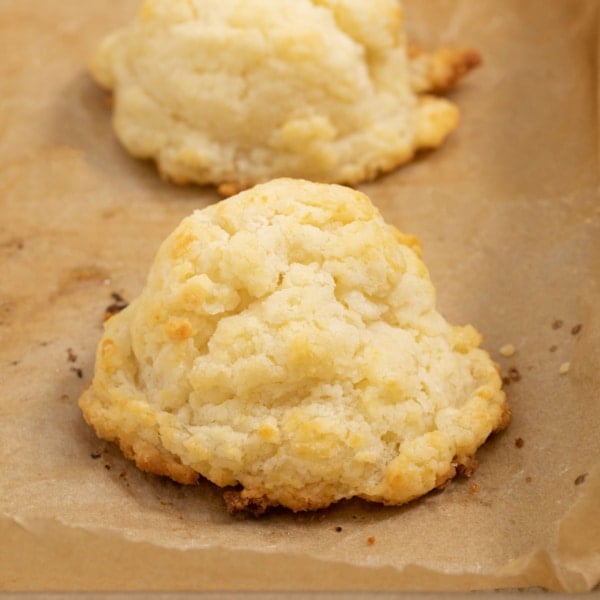
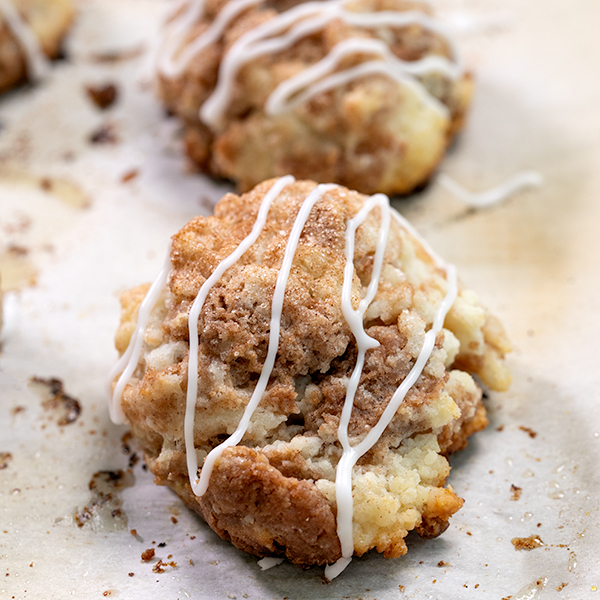









Nicole — I love your recipes and all the testing you do to ensure a great result. Just want to note that in your description you wrote, “Baking powder and baking powder.” I think you meant “baking powder and baking soda.” thank you for all your hard work and for sharing your results.
Thank you so much for pointing that out, Nancy! I really appreciate it, and I’ve made the change, as you suggested. And thank you for your kind words. They mean a lot!
Wondering if I could cut down the butter?
You need all the ingredients in these proportions to make these biscuits, Amy.
I used Better Batter, arrowroot and 1/2 cup yogurt and 1/2 almond milk. I froze the butter for 15 minutes and grated it on a cheese grater. I put it in the fridge for a few minutes. I also chilled the metal mixing bowl. When I added the butter it came out in big chunks. I used a pastry cutter to mix the batter but it came out more crumbly than in your video. I did weigh the mix and arrowroot. They taste good but are a little dense.i also put the biscuits in the fridge for 10 minutes before I put them in the oven. Any suggestions?
Since you weighted the dry measurements, if your wet ingredients were undermeasured (did you use Greek style yogurt? that doesn’t have enough liquid) or you overhandled the dough, they may come out dense. Also I would not freeze the butter. Just use it chilled from the refrigerator.
These are the best gluten free biscuits!
Forgot the stars. 5 for sure!
After months of being unhappy with my gluten free baking, I decided to take a chance on these! I’m so happy I did. I ended up substituting the buttermilk with watered down sour cream and it worked. It was wonderful making and eating a sausage and cheese sandwich. Great recipe! Thank you so much!
I’m really glad you liked the biscuits, Julie. Under the heading “How to make gluten free dairy free drop biscuits” you’ll find my suggestion for how to replace buttermilk with a nondairy substitute. The same goes for replacing buttermilk when it’s dairy.
About buttermilk. In my area there is no buttermilk except in 1/2 gallons and it’s not organic. For nearly everything that requires buttermilk I’ve been using whole milk kefir. It’s the same thickness as buttermilk and I wonder if you’ve tried it. I used plain whole milk yogurt, the runny kind, not Greek. They turned out okay, fantastic even but we usually don’t have plain yogurt in the house.
Hi, Liane, yes whole milk kefir has a similar consistency to buttermilk. Using plain yogurt will man adding too much liquid, as it sounds like you found out!
Snuck a bite after pulling out of the oven and wow, fantastic! I appreciate all your hard work in fine-tuning the recipe, Nicole. Will definitely put this into rotation. :D
I’m so happy, Tami! Thank you for letting me know, and you’re so welcome!
How exactly do you mix in the butter? For biscuits I’m used to cutting in the butter with a pastry cutter. I was confused about how exactly you mix it with the whisk. Thanks for answering. Oh and I’m dairy free, so I want to use shortening instead. Should I chill the shortening?
Hi, Kathy, please see the section on how to make these biscuits dairy free for what ingredients to use, and the rest of the text of the post for why the butter (or substitute) must be kept cold. The instructions call for whisking the dry ingredients, but mixing after you add the butter. For a visual, please see the video.
I was pleasantly surprised with these biscuits! I’ve been using your “Better than Cup 4 Cup” blend as my main flour blend for the last while and I’ve been quite happy with the results of most things. The biggest improvement I’d suggest is that you’d be a little less rude in your replies to your readers when something doesn’t work out on the first try! Nevertheless, I will be back for the food….
I don’t consider it rude to be direct when a reader says that a recipe didn’t work. My intention is to help people be successful, and my recipes are rigorously tested. My recipe and overall style is not for everyone, though, as “good enough” baking is not my intention, but it is others’. No hard feelings that it’s not for you!